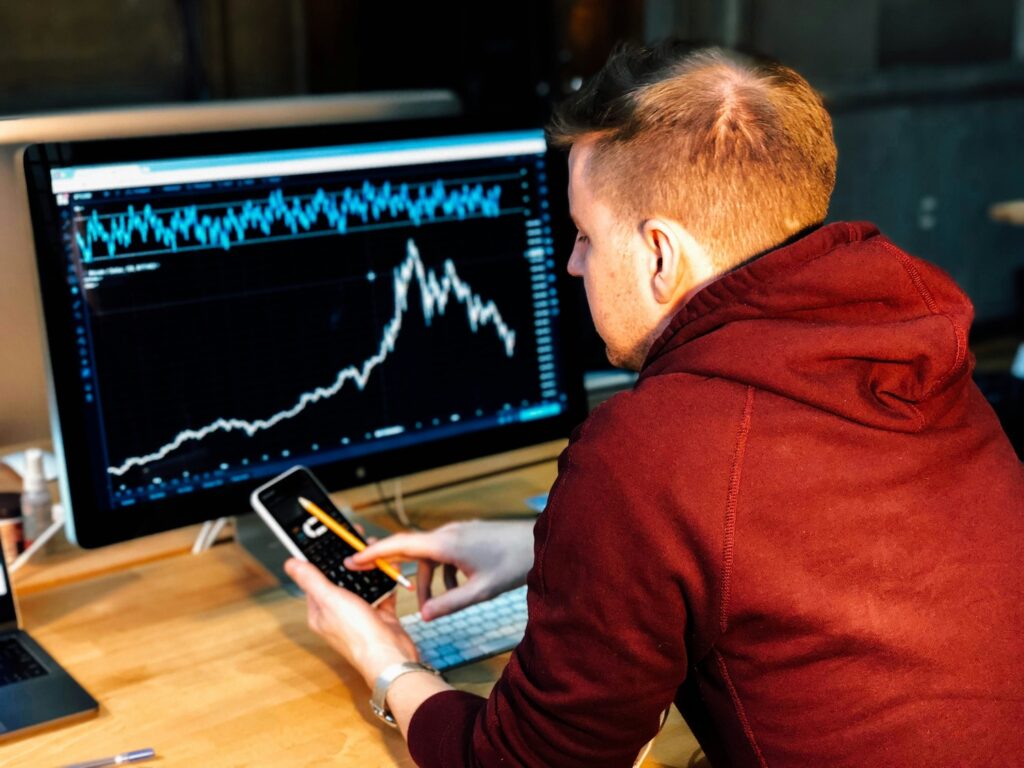In the fast-paced and competitive world of trading, success is about making the right decisions and having a refined and efficient trading process. A well-thought-out trading strategy can differentiate between profit and loss, growth and stagnation. However, refining your trading process is more than just tweaking your strategies; it’s about building a foundation of discipline, continuous learning, and adaptability that can withstand the test of market volatility.
This article explores the crucial steps traders must take to enhance their trading process, ultimately boosting their trading success. Whether you are a novice just starting your trading journey or a seasoned trader looking to sharpen your skills, refining your trading process is an ongoing endeavor that can significantly improve your performance.
By assessing your current strategies, setting clear goals, developing a robust trading plan, and continuously adapting to the ever-changing market conditions, you can create a dynamic trading process that increases your chances of success and contributes to your overall growth as a trader.
Understanding Your Current Trading Process
Refining your trading process begins with a thorough assessment of your current strategies. This self-evaluation is critical to identify what works, what doesn’t, and what can be improved. The aim is to clearly understand your trading methodology, decision-making criteria, and the logic behind your trades.
- Analyze Your Trade History: Start by reviewing your past successful and unsuccessful trades. Analyze the decisions that led to these outcomes, focusing on the reasoning behind each trade, the risk management strategies employed, and how the market conditions influenced the results. This analysis will help you identify patterns in your trading, including consistent mistakes or successful strategies that can be capitalized on.
- Evaluate Your Trading Strategy’s Effectiveness: Assess your trading strategy’s performance over time. Consider factors like profitability, consistency, and risk-adjusted returns. It’s important to evaluate whether your strategy aligns with your trading goals and is adaptable to changing market conditions.
- Identify Strengths and Weaknesses: Reflect on your trading strengths, such as discipline in following your trading plan, ability to react swiftly to market changes, or proficiency in analyzing market trends. Conversely, acknowledge your weaknesses, including emotional decision-making, overtrading, or neglecting risk management principles.
- Seek Feedback: Sometimes, it’s beneficial to get an external perspective. Engage with trading peers, mentors, or coaches to get feedback on your trading process. They can provide insights you might have overlooked and suggest areas for improvement.
- Embrace Continuous Learning: The trading environment is dynamic, with constant changes in markets, technologies, and financial instruments. Embracing a mindset of continuous learning and self-improvement is essential. Stay informed about market trends, learn from other traders’ experiences, and regularly update your knowledge and skills.
Setting Clear Trading Goals
Goal setting is a fundamental aspect of refining your trading process. Clear, achievable goals provide direction and motivation, helping to focus your efforts on what matters most in your trading journey. Here’s how you can set effective trading goals to enhance your success:
- Define Specific Objectives: Goals should be specific and quantifiable. Instead of vague aspirations like “make more money,” define precise targets such as “achieve a 20% return on investment annually” or “limit monthly drawdown to no more than 5%.” This specificity makes it easier to measure success and adjust strategies as needed.
- Align Goals with Your Trading Style and Risk Tolerance: Ensure that your trading goals are in harmony with your trading style (day trading, swing trading, position trading, etc.) and personal risk tolerance. For instance, a day trader might focus on daily income targets and risk per trade, while a swing trader might set goals around weekly or monthly gains.
- Set Short-Term and Long-Term Goals: While long-term goals provide a vision for where you want to be, short-term goals act as milestones that keep you on track. For example, a long-term goal is to build a trading portfolio worth $500,000, while short-term goals involve monthly trading performance, educational milestones, or capital allocation.
- Ensure Goals are Realistic and Achievable: Considering your experience, capital, and market conditions, goals should be challenging yet attainable. Unrealistic goals can lead to frustration and risky trading behaviors, while achievable goals can boost confidence and motivate.
- Regularly Review and Adjust Your Goals: The trading environment is dynamic, and your situation can change over time. Review your goals regularly to ensure they remain relevant and inspiring. Adjust them to reflect your current capabilities, market opportunities, and life circumstances.
Risk Management Strategies
Effective risk management is the cornerstone of successful trading. It involves identifying, analyzing, and mitigating the risks associated with trading activities to preserve capital and ensure longevity in the market. Here are key strategies to enhance your risk management approach:
- Understand Different Types of Risks: Trading risks can be market-related (price fluctuations, volatility), credit-related (counterparty failures), or operational (technical glitches, execution errors). Recognize the risks pertinent to your trading style and instruments to effectively tailor your risk management strategies.
- Implement Stop-Loss and Take-Profit Orders: Stop-loss orders limit potential losses by closing a trade at a predetermined price level. Take-profit orders lock in profits by automatically closing a trade once it reaches a certain profit level. These tools are essential for managing risk and ensuring you adhere to your trading plan.
- Manage Position Sizing: Position sizing determines how much capital to allocate to a single trade relative to your overall portfolio. It’s crucial to avoid overexposure to a single trade or market. Use risk-per-trade guidelines, such as risking only a certain percentage of your capital on each trade, to prevent significant losses.
- Diversify Your Portfolio: Diversification involves spreading investments across different assets, sectors, or markets to reduce risk. It helps mitigate the impact of a poor performance in one area on your overall portfolio.
- Regularly Monitor and Adjust Your Strategies: Monitor your open positions and overall market conditions. Be prepared to adjust your trading strategies as market dynamics change. This proactive approach can help you manage risks more effectively and capitalize on new opportunities.
- Maintain a Risk Management Plan: Document your risk management strategies in a detailed plan. This plan should include your risk tolerance levels, assessment methods, risk mitigation techniques, and contingency plans for different trading scenarios.
Continual Learning and Adaptation
In the ever-evolving landscape of the financial markets, traders who commit to continual learning and adaptation are the ones who thrive. The ability to evolve your trading process in response to market changes, technological advancements, and personal experience is crucial for sustained success. Here’s how you can integrate continual learning and adaptation into your trading routine:
- Stay Informed About Market Trends: The financial markets are influenced by many factors, including economic indicators, geopolitical events, and technological developments. Regularly consuming financial news, market analyses, and economic reports can help you understand these dynamics and their potential impact on your trading strategies.
- Invest in Education: The trading field has endless learning opportunities. Whether through online courses, seminars, workshops, or books, continuously expanding your knowledge in technical analysis, behavioral finance, and risk management can enhance your trading acumen.
- Utilize Trading Journals: A trading journal is invaluable for learning from your experiences. By systematically recording your trades, strategies, and market observations, you can analyze what works, identify mistakes, and understand your behavioral patterns, which are essential for making informed adjustments to your trading process.
- Experiment with New Strategies and Technologies: The trading world is rich with innovative strategies and technologies, from algorithmic trading to artificial intelligence-driven analytics. Experimenting with these can improve your trading efficiency and provide new insights and perspectives.
- Network with Other Traders: Engaging with a community of traders allows for exchanging ideas, strategies, and experiences. Networking can be done through online forums, trading clubs, or financial conferences. Learning from the successes and failures of others can provide practical insights and inspiration for refining your trading process.
- Embrace Adaptability: Adaptability means modifying your trading process in response to new information or market conditions. This flexibility can be the key to turning potential challenges into opportunities and avoiding rigid adherence to outdated strategies.
Implementing and Testing Improvements
Refining your trading process is an ongoing implementation, testing, and evaluation cycle. Each adjustment, whether big or small, needs to be carefully integrated and assessed to ensure it contributes positively to your trading performance. Here’s how to effectively implement and test improvements in your trading process:
- Prioritize Changes Based on Impact: Evaluate the potential impact of each proposed change on your trading process. Prioritize those likely to have the most significant positive effect on your performance, whether it’s enhancing your risk management, improving trade selection, or streamlining your execution process.
- Start with Small-Scale Testing: Before fully integrating a new strategy or tool into your trading process, test it on a small scale. This could mean using a demo account, backtesting against historical data, or applying the new method to a small portion of your portfolio. Small-scale testing helps to minimize potential losses and allows for more controlled observation of the results.
- Use Backtesting to Evaluate Effectiveness: Backtesting involves simulating a trading strategy using historical data to assess its viability. This method provides insights into how the strategy would have performed in the past and can highlight potential issues or areas for improvement.
- Monitor and Analyze Results: As you implement changes, continuously monitor and analyze the outcomes compared to your set benchmarks or goals. Pay attention to the quantitative aspects (like profitability, win/loss ratio, and drawdown) and qualitative aspects (such as stress level and decision-making process).
- Seek Feedback and Iterate: After testing and analyzing the results, seek feedback from mentors, peers, or through self-reflection. Use this feedback to iterate and make further adjustments to your trading process.
- Gradual Integration into Full Trading Routine: Once a new strategy or tool has proven effective and you are comfortable with it, gradually integrate it into your full trading routine. This cautious approach allows for adaptation and ensures that the change aligns well with your trading style and objectives.
Trading Success Begins Here
Refining your trading process is a vital endeavor that demands dedication, discipline, and a strategic approach. It’s about more than just tweaking your strategies; it’s about cultivating a mindset of continuous improvement and adaptation to the dynamic trading environment. By understanding your current trading process, setting clear goals, developing robust plans, managing risks effectively, embracing technology, and committing to continual learning, you lay the groundwork for sustained trading success.
The path to trading success is paved with diligence, insight, and continual improvement. Embrace the journey, stay committed to refining your process, and let your trading journey be one of growth, achievement, and lasting success.



